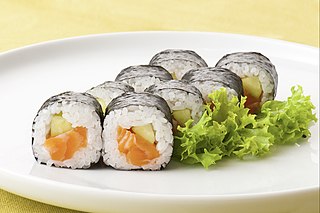
There are many sushi and sashimi ingredients, some of which are traditional and others contemporary.

There are many sushi and sashimi ingredients, some of which are traditional and others contemporary.



All seafoods in this list are served raw unless otherwise specified.
The list below does not follow biological classification.





Roe is a mass of fish eggs:






Sushi is a traditional Japanese dish made with vinegared rice, typically seasoned with sugar and salt, and combined with a variety of ingredients, such as seafood, vegetables, or meat: raw seafood is the most common, although some may be cooked. While sushi comes in numerous styles and presentation, the defining component is the vinegared rice, also known as shari (しゃり), or sumeshi (酢飯).

Sashimi is a Japanese delicacy consisting of fresh raw fish or meat sliced into thin pieces and often eaten with soy sauce.

Roe, or hard roe, is the fully ripe internal egg masses in the ovaries, or the released external egg masses, of fish and certain marine animals such as shrimp, scallop, sea urchins and squid. As a seafood, roe is used both as a cooked ingredient in many dishes, and as a raw ingredient for delicacies such as caviar.

Gimbap, also romanized as kimbap, is a Korean dish made from cooked rice, vegetables, fish, and meat rolled in gim—dried sheets of seaweed—and served in bite-sized slices. The origins of gimbap are debated. Some sources suggest it originates from Japanese norimaki, introduced during Japanese colonial rule, while others argue it is a modernized version of bokssam from the Joseon era. The dish is often part of a packed meal, or dosirak, to be eaten at picnics and outdoor events, and can serve as a light lunch along with danmuji and kimchi. It is a popular takeaway food in South Korea and abroad and is known as a convenient food because of its portability.

The history of sushi began with paddy fields, where fish was fermented with vinegar, salt and rice, after which the rice was discarded. The earliest form of the dish, today referred to as narezushi, was created in Southeast Asia from where it spread to surrounding countries. Narezushi spread to Japan around the Yayoi period. In the Muromachi period (1336–1573), people began to eat the rice as well as the fish. During the Edo period (1603–1867), vinegar rather than fermented rice began to be used. The dish has become a form of food strongly associated with Japanese culture.

Kappamaki, cucumber sushi roll, is a norimaki with cucumber core. It is a typical thin sushi roll along with dried gourd rolls and iron fire rolls.

California roll or California maki is an uramaki containing imitation crab, avocado, and cucumber. Sometimes crab salad is substituted for the crab stick, and often the outer layer of rice is sprinkled with toasted sesame seeds or roe.

Quail eggs are a kind of eggs as food, eaten and considered a delicacy in many parts of the world, including Asia, Europe, and North America. In Japanese cuisine, they are sometimes used raw or cooked as tamago in sushi and often found in bento lunches.

Poke is a dish of diced raw fish tossed in sauce and served either as an appetizer or a main course.
A dynamite roll is a Makizushi type of Western-style sushi. It usually contains a piece of shrimp tempura, avocado, and cucumber. It can also include proteins like salmon, crab, tuna, hamachi/yellowtail, vegetables like radish sprouts or oshinko, and garnishes like masago/tobiko. It is combined together with a sauce consisting of kewpie, Worcestershire, soy sauce, Sriracha or wasabi, and sometime garlic.

The B.C. roll is a Maki-zushi (roll), a kind of sushi containing barbecued salmon and cucumber. It is prepared as an uramaki roll, a style of sushi in which the rice is on the outside. Often the roll contains barbecued salmon skin coated in a sweet sauce. There are many variations of this roll including barbecued salmon skin with mayo.

Japanese cuisine has a vast array of regional specialities known as kyōdo ryōri (郷土料理) in Japanese, many of them originating from dishes prepared using local ingredients and traditional recipes.

In Japan, it is customary to serve alcoholic drinks with snacks called sakana, shukō, or otsumami (お摘み). These are usually quite salty and served in relatively small portions. Sakana are usually more substantial than tapas, although they are not considered a meal since they are not accompanied by rice. Traditionally, the Japanese regarded sake, which is made from rice, as a substitute for white rice served in a standard Japanese meal, and as a result some Japanese do not eat rice and drink alcohol simultaneously.

The Pacific bluefin tuna is a predatory species of tuna found widely in the northern Pacific Ocean, but it is migratory and also recorded as a visitor to the south Pacific.

Norimaki (海苔巻) are various Japanese dishes wrapped with nori seaweed, most commonly a kind of sushi, makizushi (巻き寿司).

Rainbow roll is a type of uramaki sushi roll filled with cucumber, avocado and crab stick. It is prepared with multiple types of fish, most commonly tuna, salmon, white fish, yellowtail, snapper, and eel. Rainbow roll is quite similar to the California roll, with the addition of tuna, salmon and avocado. Other variants include slices of mango next to avocado, or uses of imitation crab meat, fried shrimp tempura, and other seafood.
The sushi menu consists of basic Edo style sushi and they are grouped in their styles.